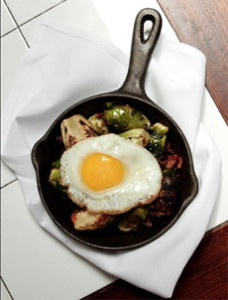TIP OF THE DAY: A Delicious Vegetable Mix At Breakfast (Ratatouille)
 [1] You can dice your ratatouille fine or chunky. A fine dice is a better base for the egg, crostini, etc.; a larger dice is better as a side dish (photo © Elegant Affairs Caterers).
|
Nutritionists expend lots of effort to get their clients to achieve nutrition goals. Americans are major under-consumers of vegetables.
There are numerous ways to add good vegetables into every meal (fried onion rings don’t count!) You don’t have to twist our arm to adopt this one: ratatouille at breakfast. It can be served with eggs or polenta. See the recipe variations below, along with other ways to serve ratatouille. Ratatouille (rah-tah-TOO-ee) is a vegetable side dish that originated in the Provence region of France. The classic recipe consists of sautéed eggplant, onions, tomatoes, yellow squash, zucchini plus garlic and herbs. Sometimes, each vegetable is sautéed separately, then layered into a baking dish and baked (check out the beautiful tian). Modern recipes make it easier: We fully sauté groups of vegetables with similar densities, combine them and don’t bake them. You can customize the dish as you like—for example, with bell peppers, celery, fennel, olives, onions and yellow squash. There are similar dishes in other Mediterranean countries, including: We misplaced our nana’s ratatouille recipe card; but the recipe below, adapted from TheFormerChef.com, looks almost identical. Ratatouille is delightfully colorful when you use red, yellow and/or orange bell peppers and tomatoes/cherry tomatoes. Regarding the tomatoes: Ratatouille has traditionally been a summer dish, when tomatoes, zucchini and yellow squash are plentiful. While you can find decent squash in the off season, imported tomatoes can be both pricey and lacking in flavor. You can substitute cherry, grape or sundried tomatoes; or use diced canned San Marzano tomatoes. Canned tomatoes don’t need to be sautéed; just drain them and add them to the final heating. |
|
|
RECIPE: RATATOUILLE We make double recipes and microwave the ratatouille (or other sautéed vegetables) from the fridge while the eggs are cooking. Ingredients 1. HEAT 2 tablespoons of the olive oil in a large sauté pan or skillet†, over medium-high heat. Add the onions and sauté until they are translucent, about 5 minutes. Add the bell peppers and sauté for another 5 minutes. Add the garlic and cook 2 minutes more. Transfer the sautéed vegetables to a bowl and set aside. 2. RETURN the pan to the heat and add 2 more tablespoons of olive oil. Add the zucchini and yellow squash and cook until tender, about 5-7 minutes. Add them to the onions and bell peppers. 3. Return the pan to the heat and add the final 2 tablespoons of olive oil. Add the eggplant and sauté for 2 minutes. Add the 1/4 cup of water; the eggplant will absorb all the oil very quickly and the water will help it cook before it burns. When the water is absorbed and the eggplant begins to soften (about 5 more minutes), add the chopped tomatoes to the eggplant. 4. COOK the tomatoes until they start to break down and the eggplant is soft, but not mushy. Add the rest of the vegetables back into the pan, folding it all together with a large spoon. 5. Cook for another 5 minutes and add the fresh herbs. Season with salt and pepper. Don’t overcook; you want the flavors to remain fresh and distinct. Plus, if you plan to reheat the ratatouille at a later time, it will cook more then. *Capers are the flower bud of the caper bush, Capparis spinosa. Caperberries are the fruit with seeds inside. Both are brined and thus contribute saltiness as well as flavor to dishes. They are members of the same botanical order as cruciferous vegetables, Brassicales, but a different family. †While the pans can usually be used interchangeably, a skillet or frying pan has slanted sides and a sauté pan has straight sides. A skillet has a larger bottom surface area, and its straight sides are better for making an omelet or frittata—even though you may see slope-sided pans marketed as “omelet pans.” |
||
|
RECIPE VARIATIONS
Serve any of the following, and don’t hesitate to mix them together. Ratatouille is a side dish that’s great with grilled fish or seafood on Meatless Monday, or as a side anytime with grilled or roasted beef, chicken, lamb or pork. But you can also: |
 [4] Go cruciferous: Place your egg atop sautéed Brussels sprouts, collards or mustard greens. At Olio e Piú in New York City, the Brussels sprouts are mixed with radicchio (photo © Olio e Piú).
|
|
|
We’re off to make breakfast: ratatouille and fried eggs (no surprise). ___________________________________ ‡You can find whole grain couscous; but most supermarket products are not whole grain.
|
||


